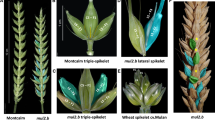Summary
The phenology and build-up of spikelet number under 10 h day-length were studied in five wheat lines: the multispikelet line ‘Noa’, the regular line ‘Mara’, the F1 hybrid between them and monosomics 2D of ‘Mara’ and of this hybrid (lacking the 2D chromosome of ‘Mara’). ‘Noa’ had a longer spike development phase, a higher initial number of spikelet primordia and a slower rate of spikelet production than ‘Mara’. The F1 hybrid was similar to ‘Noa’ in its high initial number of spikelets and to ‘Mara’ in its high rate of spikelet production. This hybrid had a shorter spikelet phase than both parents. Deletion of one dose of the ‘Mara’ 2D chromosome from either ‘Mara’ or the F1 hybrid caused a reduction in the rate of spikelet production and an increase in the duration of the spikelet phase. These effects were due to the reduced dosage of the 2D chromosome. However, in the F1 hybrid this deletion also caused an increase in the spike development phase — an indication that ‘Noa’ carries on its 2D chromosome a recessive gene for late heading date which acts on the spike development phase. This gene of ‘Noa’ is independent of the day-length sensitive gene ppd, and is different from ‘Noa’s dominant gene for large initial number of spikelets.
Similar content being viewed by others
References
Halse NJ, Weir RN (1970) Effect of vernaligation, photoperiod and temperature on the phenological development and spikelet number of Australian wheat. Aust J Agric Res 21:383–393
Millet E (1983) Breeding for large number of spikelets per spike in wheat. In: Sakamoto S (ed) Proc 6th Int Wheat Genet Symp Kyoto, pp 623–628
Millet E (1986) Developmental differences between wheat lines with regular and multispikelet spikes. Z Pflanzenzucht (in press)
Scarth R, Kirby EJM, Law CN (1985) Effects of the photoperiod genes Ppd1 and Ppd2 on growth and development of the shoot apex in wheat. Ann Bot 55:351–359
Scarth R, Law CN (1983) The location of photoperiod gene Ppd2, and an additional genetic factor for ear emergence time on chromosome 2B of wheat. Heredity 51:607–619
Scarth R, Law CN (1984) The control of the day-length response in wheat by the group 2 chromosomes. Z Pflanzenzücht 92:140–150
Welsh JR, Keim DL, Pirasteh B, Richards RD (1973) Genetic control of photoperiod response in wheat. In: Sears ER, Sears LMS (eds) Proc 4th Int Wheat Genet Symp. University of Columbia, Missouri, pp 879–884
Worland AJ, Law CN, Parker BB (1983) Alternative semidwarfing genes. In: Annu Rep Plant Breed Inst. Cambridge, pp 59–61
Author information
Authors and Affiliations
Additional information
Communicated by J. MacKey
Rights and permissions
About this article
Cite this article
Millet, E. Genetic control of heading date and spikelet number in common wheat (T. aestivum L.) line ‘Noa’. Theoret. Appl. Genetics 72, 105–107 (1986). https://doi.org/10.1007/BF00261463
Received:
Accepted:
Issue Date:
DOI: https://doi.org/10.1007/BF00261463




